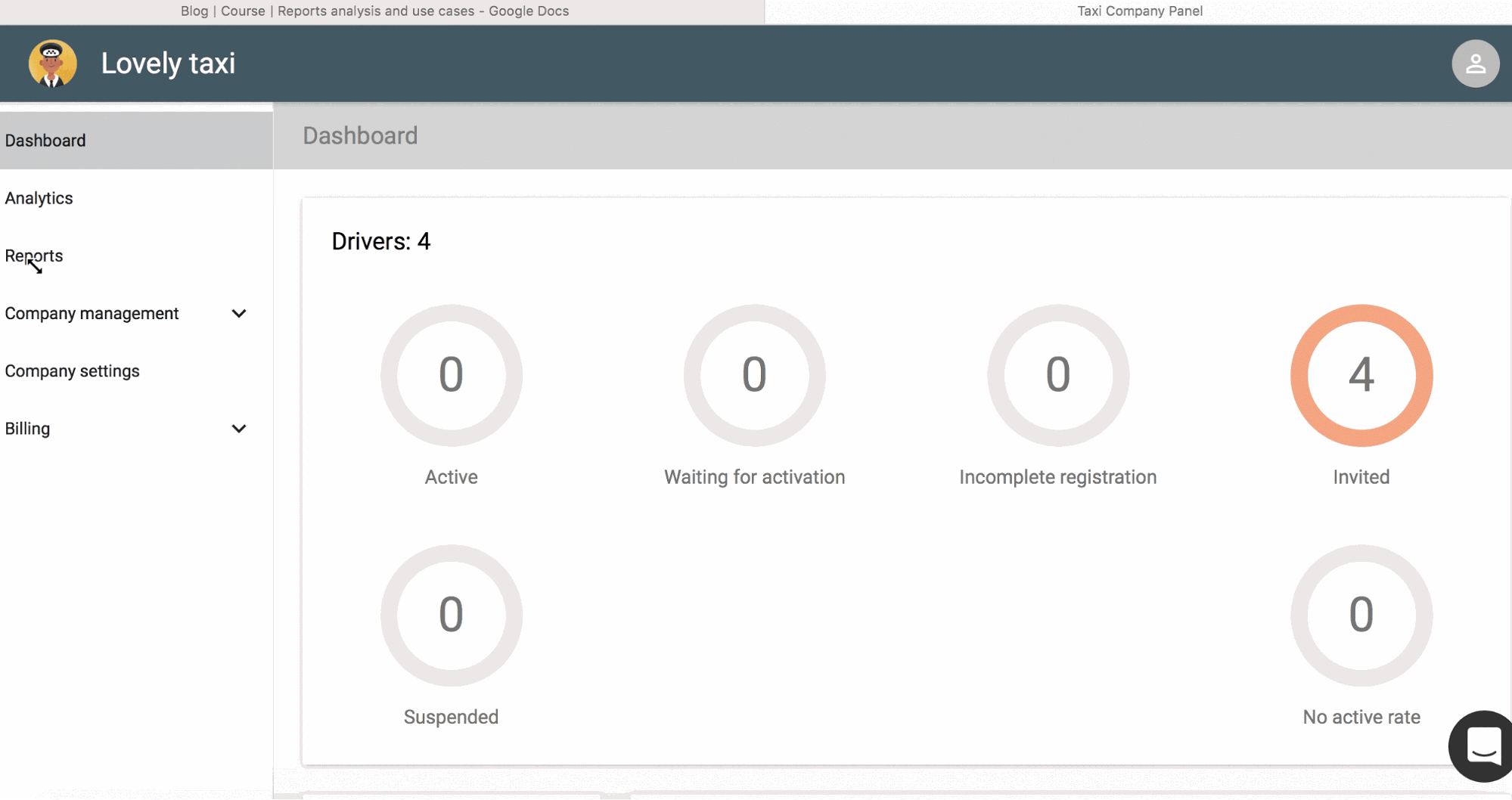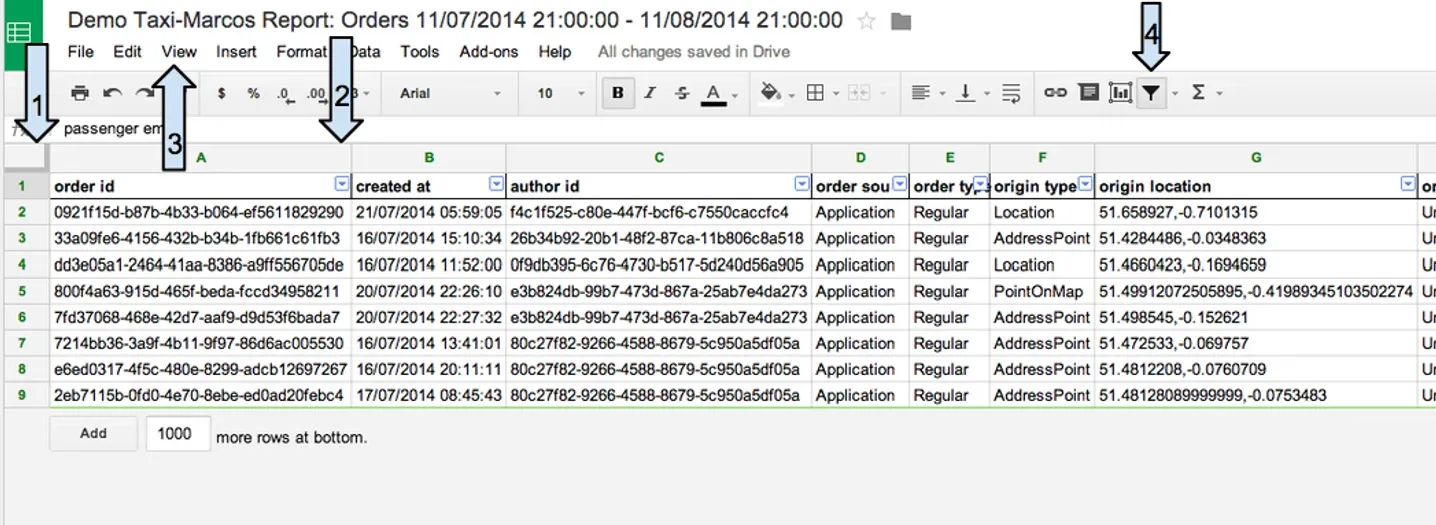Reports analysis and use cases
You definitely know there’s a lot of information stored in your My hub. All the valuable business data about how clients interact with your services, how the dispatchers and drivers do their jobs, the orders and the payments done within the system.
Below, you can see the whole process of getting to the reports tab and downloading some reports to your computer to Google Disk. We advise to download the reports to Google Disk though, because it gives you an easy way to filter and analyse all this data.

After loading your reports to Google Disk, enjoy editing and filtering them in any way you need to analyse company business performance. On the sample below, you see how this can be done.

In fact, the information stored in Reports is a unique source of growth insights for your business: you can manage the clients flow, drivers and operators workloads and efficiency, use data for marketing activities and promotions, etc. Let’s see how you can use every specific report type.
Clients reports
What kind of data do you get
Here, you can find a detailed list of data gathered in Clients reports of your company. Long story short, Clients reports provide you with:
- Passenger email addresses and telephone numbers;
- Passenger profile status (active/invited/closed);
- The number of orders made, paid and cancelled (reasons specified).
How to use it
Being a massive database of passengers information, Clients reports contain everything you need to make the communication with clients more efficient.
The most obvious thing is targeting your marketing activities. Having passenger contact details is necessary for launching referral and engagement campaigns. For instance, one can pick out the passengers who’ve completed a certain number of trips to provide them with a special discount or promotional action — via email or SMS.
Clients reports are also a perfect source of information if you want to compare clients activity over several reporting periods. This can give you more insights into the busiest periods of company work, a potential number of drivers needed, and revenue flows.
Analysing the numbers of cancelled orders and cancellation reasons can help you adjust cancellation fees on one hand, and tackle problems with the clients who abuse the system in any way on the other hand.
Drivers reports
What kind of data do you get
- Complete driver’s information (name, email, contact number, licence number, any notes made by dispatchers);
- Driver profile status (active/invited/not activated/suspended/closed);
- Full information about the vehicle (type, model, color, production year, plate number, board number, seat capacity);
- Total number of orders a driver performed during the reporting period;
- Total number of offers received by a driver during the reporting period;
- The number of accepted/rejected/ignored offers the driver had during the reporting period;
- Total amount added to and debited from driver’s balance during the reporting period;
- Total service fees, total transaction fees;
- Paid orders total and unpaid orders total;
- Cancelled orders (by reason);
- Finished orders, paid and unpaid.
You can check out the full list here.
How to use it
Drivers reports are there for you to keep an eye on the drivers’ productivity and strategize fleet management.
First of all, it’s a perfect source of information for solving any complaints or concerns. You can always compare what a customer says with what the system actually registers. With Drivers reports, you’ve always got a clear picture of every driver’s performance.
The data on the number of offers accepted, rejected, ignored, cancelled, and the transaction fees totals can be used to make decisions on the further fleet policy. For instance, you can suspend drivers who reject or ignore orders, give bonuses to the hardworking drivers (via giving manual balance top-ups or providing subscription privileges).
Orders reports
What kind of data do you get
- Unique identification number of every order (Order ID);
- Date and time of order creation, order source (Customer app, - Operator app, Web App) and the order source ID;
- Bundle identifier — the app used to create an order (iOS, - - - Android, web application, Taxi Buttler, Web App);
- Requested vehicle type (service type the client booked), requested service date and time.
- Origin (pick up) type, it’s exact location (GPS coordinates) and address;
- Destination type, location (GPS coordinates of the drop off requested), and address;
- Drop off information: type, location, and address;
- Passenger’s phone number, ID, name, email, any notes added;
- Dispatcher’s info: ID, name, email, phone number;
- Driver’s data: ID, name, email, phone number, vehicle type/plate and board number, main service type the driver works with;
- Estimated time of the driver’s arrival, estimated distance;
- Number of times the system makes an offer to the drivers until it’s accepted;
- The number of drivers who’ve rejected the offer;
- Total number of bids for the order;
- Order final status, actual trip distance, duration, final cost, extra fees, coupon discounts, reasons if unpaid;
- Payment method, card, errors if occur;
- Ratings by driver and passenger;
- Actual pick up location, arrival time, arrival location, drop off location, drop off time, the time and the location where the driver has finished the order.
How to use it

Yeah, it’s a lot. To avoid pain, let’s see how to use this, exactly.
- The number of cancelled orders can help you to regulate cancellation fees.
- The cancellation reasons are there to make troubleshooting easier.
- Every detail of each particular order can be checked up, which makes it much easier to solve any problems between customers and employees.
- Knowing all the pickup points per period of time you can see what locations are the most popular and send more drivers there in order to work more efficiently.
- Plus, knowing the popular origin and destination locations can be a source of ideas on business partnerships.
- You can see what service types are the most popular and manage your fleet and driver subscriptions accordingly.
- Driver and passenger ratings can be a source of valuable information about how the services actually work out for customers and employees.
Operators reports
What kind of data do you get
- Dispatcher ID, name, email, phone, profile state;
- The total number of orders;
- The total number of cancelled orders (cancellation reasons specified);
- The number of finished paid and unpaid orders.
How to use it
Okay, this type of reports is only useful for companies that work with an Operator app. But hold your horses scrolling to the next paragraph: it’s also a source of precious information for those who work with Partner access — and you know how profitable this feature is, right?
Of course, the main reason to download Operators reports is seeing how exactly productive the dispatchers are. You can also check up the reasons in case their productivity is not really stunning: maybe they simply cannot perform better because there are not enough vehicles?
The same works for Partner access operators: you can see which partnerships turn out the best, and adjust your partnership offers and policy accordingly. 🙌
Payment reports
What kind of data do you get
- Payment ID, date;
- Payer type (= payment source: Customer app or Third-party payment);
- Payer ID, name, phone number, email;
- Payment method, status, the exact amount paid, currency;
- The last 4 digits of the card used for payment;
- Reference ID (= Order ID);
How to use it
The first and the most obvious charming thing about Payment reports is that you can see how do people prefer to pay — and shape your pricing policy accordingly.
Another thing is that in case you accept credit cards, Payment reports are a goldmine of data needed if any problems occur with banks or payment gateways. You see, each payment is attributed to an order (that’s why a Reference ID is an Order ID). Any payment process can be tracked using this Reference ID. This is extremely useful in cases when something goes wrong with a payment and nobody has a clue why. Isn’t that great?
Summary
As you can see, Company reports is a perfect solution for gathering all kinds of precious data on your business performance. You can use the reports to get a plenty of valuable insights needed for planning and managing business goals. There are 5 types of reports you can request for any period of current interest:
- Clients reports. Clients reports contain everything you need to make the communication with clients more efficient: contact details and activity statistics. As a result, Clients reports are perfect for analysing the app performance and planning marketing moves.
- Drivers reports. These reports are indispensable for keeping an eye on the drivers’ efficiency and strategizing your fleet management.
- Orders reports. These reports are a goldmine of information on customer experience: with it, solving any problems between customers and employees is much easier. You can also see the most popular locations in Orders reports, and adjust your fleet accordingly. However, there’s much more to this type of reports — in fact, it’s our favourite one!
- Operators reports. Especially useful for companies who work with Operator app and Partner access, this type of reports allow to get a clear idea of the dispatchers’/partner operators’ productivity.
- Payment reports. This reports type is there for you to see which ways people prefer to pay — and shape your pricing policy accordingly. It also provides a possibility to address any payment-related problems occurring.
